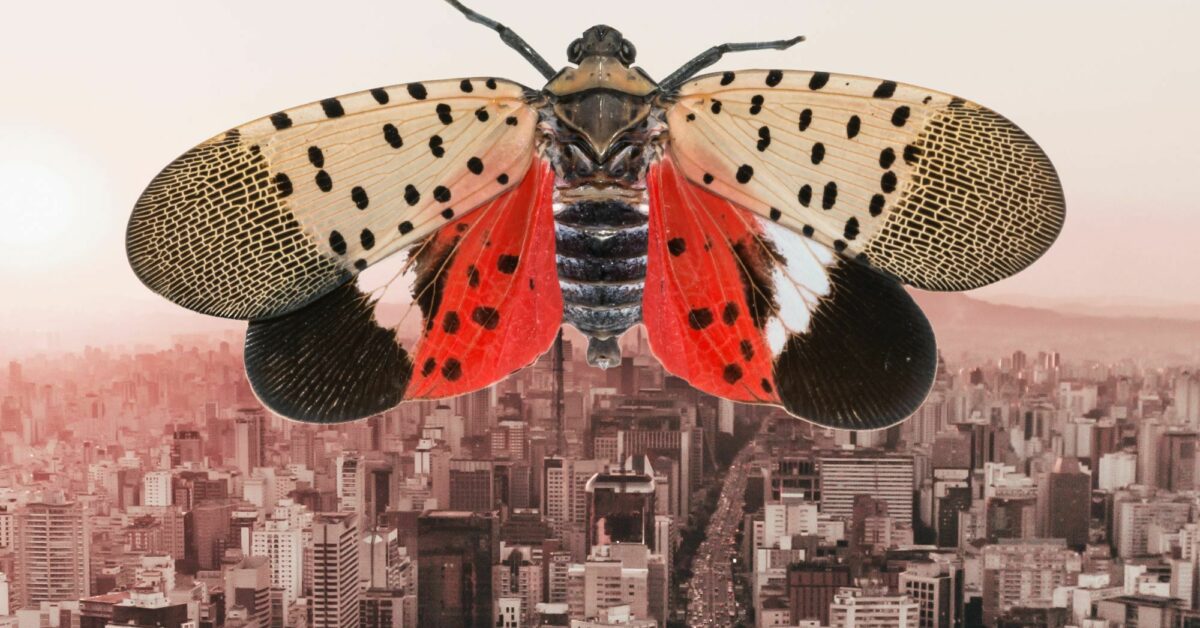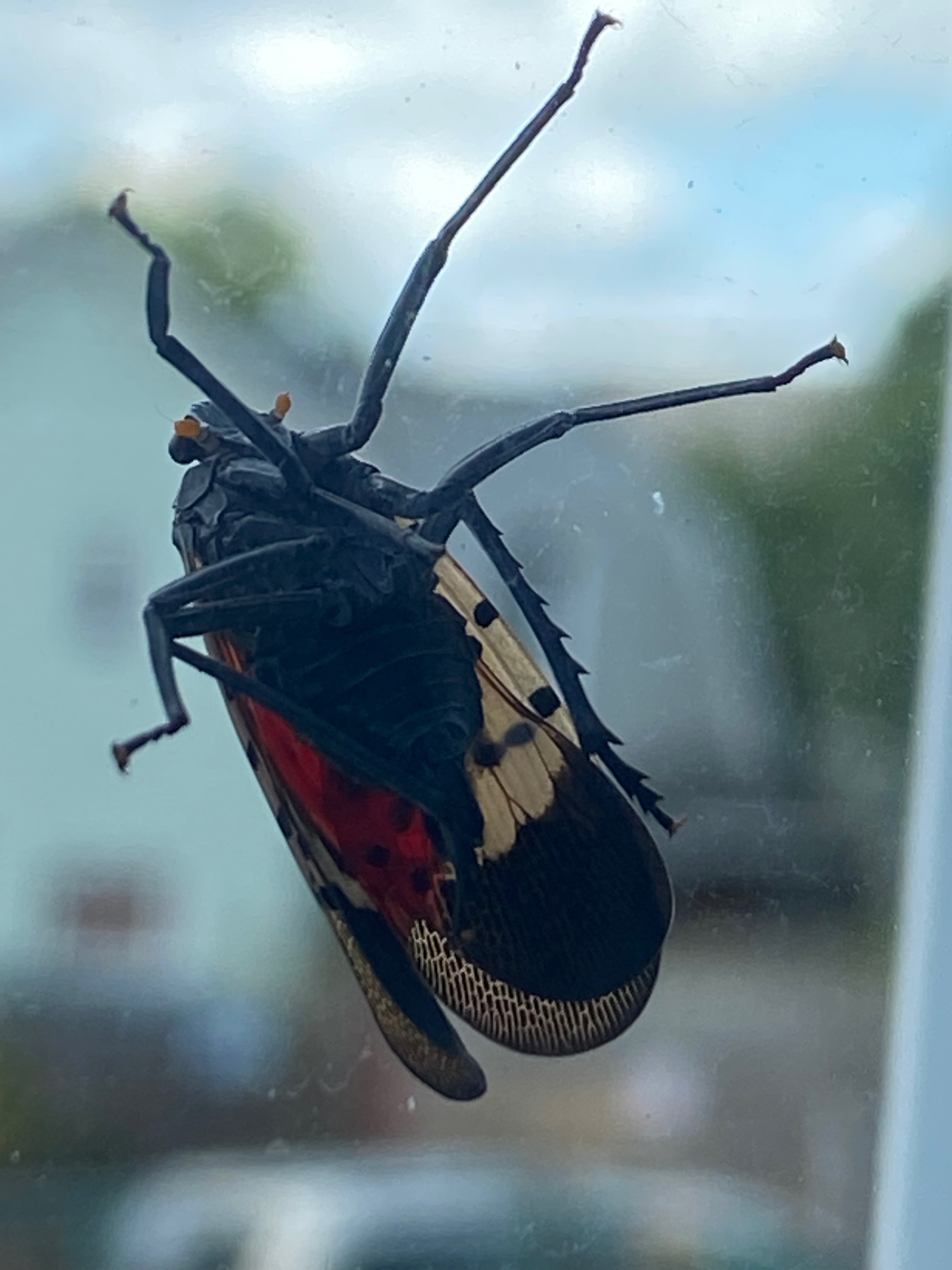Stomping Spots: Queer Feelings for a Bad Bug Heading to Michigan
When an invasive insect gets smashed, what is really going on?

Fall has arrived, but the summer "let's party" feeling blazes on in the rumbling "unn-chaa" of outdoor speakers under a city bridge. My head tilts back, torso swaying with the music, and my eyes fill with the poolside blue of a late summer sky. Then, a little buzzing silhouette rips across the blue, alongside the edge of the bridge platform — a spotted lanternfly. Other lanternflies crawl along the gravel in front of me, scale my pant leg and land on the back of my neck. Here in Pittsburgh, they're everywhere. Michigan will come to know them soon enough.
The spotted lanternfly — scientific name Lycorma delicatula — is a plant-hopping insect. Most are roughly an inch long, with wings that make me think of textiles: rough dots and sparrow-like striations. Underneath these forewings are red hindwings tipped with black and white. The spotted lanternfly flies a little bit, but it's mostly a jumper — six to nine feet at a leap. Using piercing mouthparts, the spotted lanternfly sucks liquid from the stems of plants, leaving farmers concerned for future crops.
Although spotted lanternfly feeds on plant sap, their feeding rarely results in plant death — though feeding by many lanternflies at once can significantly weaken a plant’s resistance to other problems. Heather Leach, a research technician at Michigan State University's Wilson Lab for Tree Fruit Entomology, says that estimates of damage by spotted lanternflies are "really difficult to obtain" because the insect "feeds on plant sap, and doesn't directly feed on the fruit/vegetable/etc. For pests that do, we can more easily calculate the damage and economic loss." Leach explains that, in the landscaping and ornamental plant industries, the primary losses have been economic; for example, the costs of applying pesticide to control spotted lanternfly populations and prevent the transportation of eggs.
There's so much I could tell you about lanternflies, but I'm forestalling the inevitable:
I don't want to tell you this, but they're invasive, arriving from China in 2014. Without a dedicated predator on these shores, spotted lanternflies have covered telephone poles, amassed on building walls and dappled trees here in Pittsburgh. It's a considerable ecological and visual update. Nearly a decade after the lanternfly’s arrival, there's a hotline for reporting the insect in Pennsylvania: 1-800-4BAD-FLY. Almost uniformly, spotted lanternfly is unpopular in these parts. According to Neal Rubin at the Detroit Free Press, spotted lanternflies will inevitably become a common sight in Michigan, too.
Stomping is the most popular response. I've seen a queer post-punk go out of their way to put chunky boot to delicate jumping legs. A child almost matched glass to teeth, stumbling towards a restaurant window to crunch a bug. Crushed bugs dot the steps outside the museum of art, as though Yayoi Kusama had gone for direct rather than symbolic violence. Poet Alina Pleskova sums up the popular response:
This summer in Philly, a directive to kill spotted lanternflies
formed citywide camaraderie: an outlet for our dislocated furies.
The ecology of North America is forever changed. It’s hard to make sense of such a big idea, so we stomp.
Catriona Sandilands, a professor of Environmental Arts and Justice at York University, suggests this is the trouble at the center of our climate-changing era: Things like the spotted lanternfly show up, and we do everything we can to "save" a little bit of nature. Then, when the next oil rig bleeds out, the next train jumps the track and the next ba-fuckin'-jillion tons of natural gas burns up, we head off to the next cause, too. It's a constant consumption of ever-interchangeable near-crises.
Sandilands writes that this parade of causes du jour keeps us from ever settling down with the grief of watching this planet become uninhabitable for us — toxic for others. Spotted lanternfly isn’t a harbinger of climate change per se, but it’s thriving in the midst of other changes that make trouble for crops and ecosystems. And it’s bad, we’re told. Invasive, a pest. For the good of the planet, we have to stomp the spotted lanternfly. No time to ask how else we might feel: Guilty, perhaps. Regretful. Admiration or aesthetic joy. No, stomp.

Being "invasive" is a matter of context. According to the National Invasive Species Information Center, an invasive species is non-native to the ecosystem in question and "likely to cause economic or environmental harm or harm to human health." In other words, the species did not arrive in its present location without hitching a human ride, and now it’s doing something humans don't like. Spotted lanternfly is native to China and feeds on agriculturally significant plants like grapes, fitting NISIC's criteria. That second criterion distinguishes invasive species from North American non-natives, like house cats, dairy cows, honeybees and earthworms. (All of whom have caused harm at some point.)
Fluffy, fuzzy tamarisk trees are considered invasive in the English city of Brighton. Lining a seaside tract known as "Duke's Mound," tamarisks obscured little nooks that became suites for gay cruising and public sex. The sex wasn't a secret, and AIDS-phobic attitudes kept some locals off the Mound for fear of a virus in the trees.
In recent years, local authorities have replaced non-native tamarisks with native plants because the tamarisks were "limiting all other species and discouraging people from accessing the area." That is to say: The species present isn't the right species; the people accessing the area aren't the right people. As Harrie Neal writes, "Though not explicit, the subtext of the [...] remarks seems to be that if tamarisks are a threat to native species, then so are the people who visit them."
I relate. I’m not even supposed to be here, according to a wide swath of American voters. According to them, I’m a threat to the family and the nation. You’ll catch what I’ve got — whatever’s the sex/gender scare-of-the-day — if you get too close. I should be violently changed or destroyed, according to them. Now, I’m being asked to smash a stunning, curious creature because it poses a potential, spreading threat. No time to catch my breath and think: This continent is forever changed. This planet is forever changed. Are you angry? I’m angry. An expression of fury, like poet Pleskova describes, is maybe a better reason to stomp than "saving nature" from spotted lanternfly.
You can stomp, or you can fold. You can draw and wax it over. You can ask what you can’t see when you hide a spotted lanternfly under your shoe. That’s what Imin Yeh, associate professor of art at Carnegie Mellon University, is asking. Yeh makes paper sculptures that look like the everyday objects we speed past — table salt, saltines, pencil shavings, lucky pennies. She makes paper-spotted lanternflies, too. “I was first attracted to spotted lanternflies because their wings look like etchings.” Her sculptures help us ask questions that sound something like: If we could slow down, so slow that the word "invasive" becomes a low hum, what else might we notice about the spotted lanternfly? What would ‘invasive’ sound like when we returned to the speed of everyday life?
Leaving my meeting with Imin, I walk past a library entrance where two columns rest on stone plinths. A student is undertaking a difficult maneuver: lifting her leg more than 90 degrees to smash a spotted lanternfly on one of the plinths. She almost falls over, almost wrenches her leg from its joint.
You can’t tell me that’s just about a bug.









